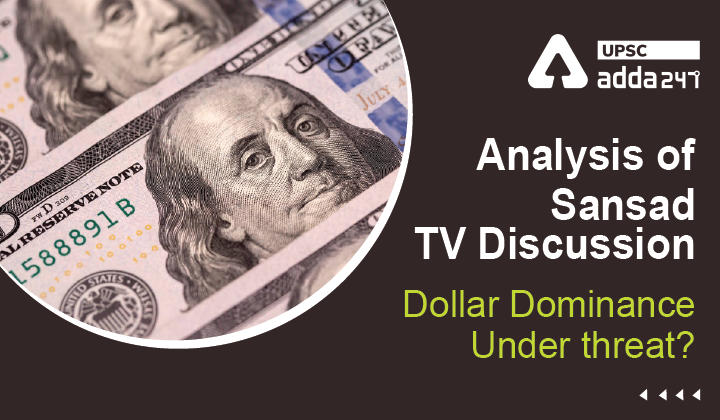Table of Contents
Relevance
”GS 2: Effect of Policies & Politics of Countries on India’s Interests”
”GS 3: Monetary Policy, Liberalization”
Context
- The US dollar, which is the world’s reserve currency, can see a steady fall in the current context as leading central banks may look to diversify their reserves away from it to other assets or currencies like the Euro, Renminbi or gold.
- Financial sanctions imposed on Russia threaten to gradually dilute the dominance of the U.S. dollar and could result in a more fragmented international monetary system.
- On March 23, Russian President Vladimir Putin demanded that European countries must pay for all-natural gas imports in rubles instead of the US dollar or the euro.
Impact Of Russia-Ukraine War on Global Economy
- Beyond the suffering and humanitarian crisis, the war has dealt a major blow to the global economy.
- The World Bank has lowered its annual global growth forecast for 2022 by nearly a full percentage point, from 4.1% down to 3.2%, citing the pressure that Russia’s invasion of Ukraine has placed on the global economy.
What is Dollar Dominance?
Background
- In the early 1970s US done a deal with the oil-rich Kingdom of Saudi Arabia to conduct global energy trade in dollars.
- The status of the dollar was enhanced by the collapse of the Bretton Woods system, which essentially eliminated other developed market currencies from competing with the USD.
- This status of the reserve currency allows the US government to refinance its debt at low costs in addition to providing foreign policy leverage.
Current Status
- From the dominant reserve currency for central banks to the main conduit for global trade and borrowing, U.S. dollars are the lifeblood for banks and markets around the world.
What Could trigger a faster de-dollarisation?
- The weaponisation of trade, the imposition of sanctions and the exclusion from SWIFT by the US could trigger a faster de-dollarisation as countries displaying diplomatic and economic autonomy will be wary of using US-dominated global banking systems.
- This can also trigger a shift in the overall global forex market framework as potential foreign policy coercion or sudden disruptions will not go down kindly with countries, which will start exploring how to build bulwarks.
- Efforts are already underway for the possible introduction of a new Russia-China payment system, bypassing SWIFT and combining the Russian SPFS (System for Transfer of Financial Messages) with the Chinese CIPS (Cross-Border Interbank Payment System).
- The notion of de-dollarisation sits well in the thought experiment of a multipolar world where each country will look to enjoy economic autonomy in the sphere of monetary policy.
What did Russia do for De-Dollarisation?
- Russia had started its three-pronged efforts towards de-dollarisation in 2014 when sanctions were imposed on it for the annexation of Crimea.
- First, Russia reduced its share of dollar-denominated assets to about 16 per cent in 2021.
- It had already announced that it would be cutting the USD from its $186 billion National Wealth Fund.
- Second, it reduced its share of trade conducted in USD by prioritising national currencies in bilateral trade.
- The use of USD in Russia’s exports to BRICS crashed from about 95 per cent in 2013 to less than 10 per cent in 2020.
- Third, Russia also developed a national electronic payments system called “Mir” in 2015 after several payment processing firms denied services to Russian banks.
What did China do for De-Dollarisation?
- China aims to use trading platforms and its digital currency to promote de-dollarisation.
- China has established RMB trading centres in Hong Kong, Singapore and Europe.
- In 2021, the People’s Bank of China submitted a “Global Sovereign Digital Currency Governance” proposal at the Bank for International Settlements to influence global financial rules via its digital currency, the e-Yuan.
- The IMF has already added Yuan to its SDR (Special Drawing Rights) basket in 2016.
- In 2017, the European Central Bank exchanged EUR 500 million worth of its forex reserves into Yuan-denominated securities.
Why it is not an easy task to DeDollarise?
- The US dollar continues to reign, having Currently, about 60 per cent of foreign exchange reserves of central banks and about 70 per cent of global trade is conducted using USD.
- The association of the USD as a “safe-haven” asset also has a psychological angle to it and like old habits, people continue to view the currency as a relatively risk-free asset.
- Given this psychological bias, the world will continue to prefer the USD as a “store of value” and a “medium of exchange”, fulfilling the basic functions of money.
- Additionally, sudden dumping of dollar assets by adversarial central banks will also pose balance sheet risks to them as it will erode the value of their overall dollar-denominated holdings.
Conclusion
Despite triggers to the move away from the dollar, in reality, it will be a protracted process. Apart from the Euro and gold, most other foreign currencies have some inherent risks associated with them.



 TSPSC Group 1 Question Paper 2024, Downl...
TSPSC Group 1 Question Paper 2024, Downl...
 TSPSC Group 1 Answer key 2024 Out, Downl...
TSPSC Group 1 Answer key 2024 Out, Downl...
 UPSC Prelims 2024 Question Paper, Downlo...
UPSC Prelims 2024 Question Paper, Downlo...




